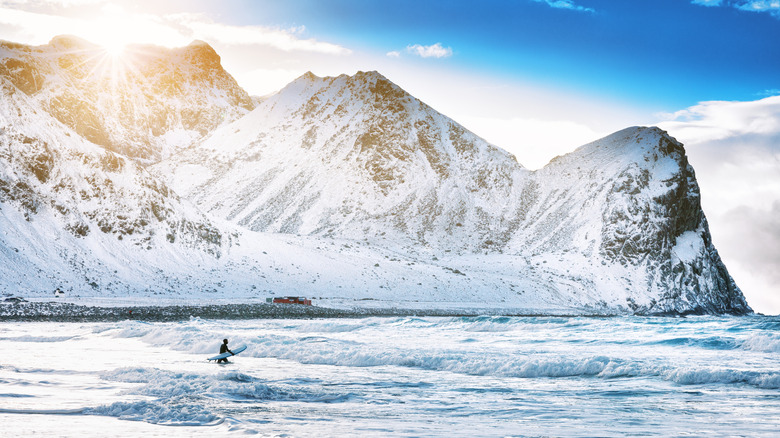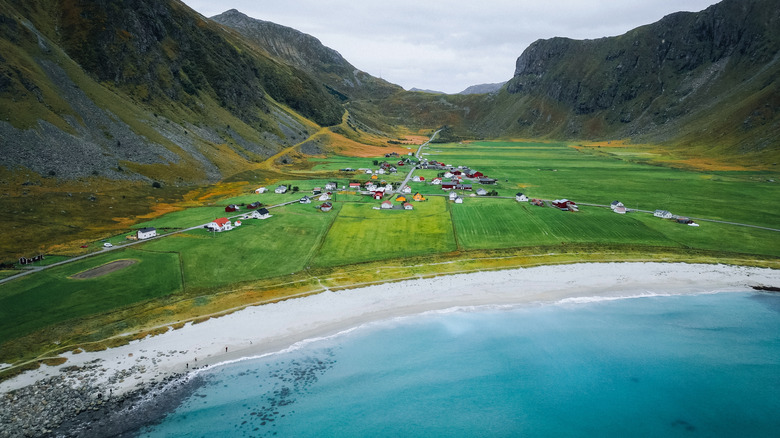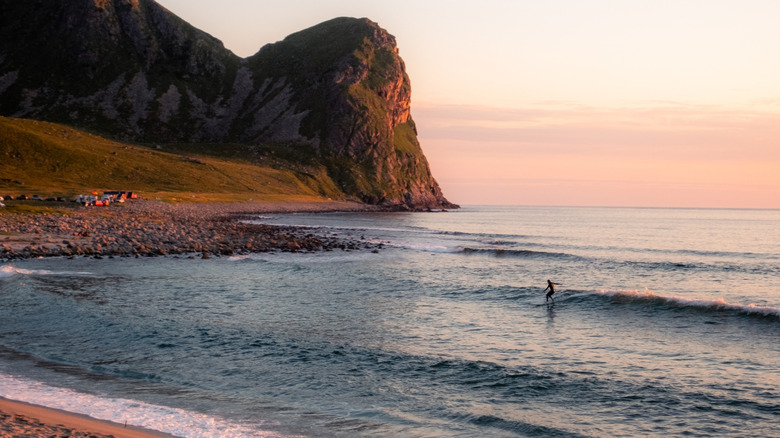Turquoise Waves And White Sand Beaches Await Surfers On These Islands Above The Arctic Circle
Norway is famous for a lot of things, from Vikings and ice fishing to fjords and incredible wintery landscapes. In general, the country is known for its dramatic beauty, and when it comes to incredible Norwegian landscapes, the Lofoten Islands stand out. Picture snow-covered peaks jutting straight up from the ocean, traditional red houses dotting the coastline, and the northern lights dancing over the water.
The icy waters around the Lofoten Islands don't exactly scream "beach vacation," but the destination features pristine sands and crystal-clear water. In addition to being one of the best polar bear plunge destinations to ring in the New Year, there are also some serious surf breaks that attract adventurers from all over the world.
Improved wetsuit technology over the last 30 years or so has increased the popularity of cold-water surfing in places above the Arctic Circle (like the Lofoten Islands). Now, surfing is a year-round activity in the upper reaches of Norway, and the best time of year just happens to be winter. It's going to be cold, of course, but catching a wave in the shadow of a snowy peak will definitely be a story for your grandkids. After the sun sets, you'll be able to spot the northern lights if you're lucky — after all, Norway is one of the best destinations for the next big travel trend of "Nocturism."
Cold-water surfing in Norway's Lofoten Islands
The popular old Norwegian saying, "There's no such thing as bad weather, just bad clothing," doubly applies to surfing in the Lofoten Islands. Especially in winter! Wetsuits are now thick enough that cold-water surfing in the icy waters of the Lofoten archipelago has been possible since the late 1990s. Surfers need to ensure that their wetsuit is at least 6/5 millimeters thick, with their hands and feet fully covered in 7-millimeter-thick gloves and booties. Water temperatures never get warmer than 55 degrees Fahrenheit, and in the winter, the outside air can be below freezing. One tip to stay warm? Zip up your wetsuit in a warm spot because if you get into it while cold, it'll be hard to get your body temperature up.
While late fall to spring is the best time for surfing regarding wave size and consistency, the gentler swells in the summer attract more beginners. Of course, the midnight sun also brings the world's longest island sunset in the months of June, July, and August. Surfers can essentially be on the water 24 hours a day, and no surfer can resist that magical allure, whatever the waves are doing. The allure of having this much daylight in the Arctic Circle is also why travel expert Rick Steves says summer is the best time to visit Iceland.
Surf year-round off the beaches of Unstad and Flakstad
When it comes to the best beach vacation destinations in Europe, you're probably thinking more along the lines of the Mediterranean Sea than the Norwegian Sea. But the beaches in Norway, especially the Lofoten Islands, are world-class. The water is known for its turquoise clarity, giving the landscape a similar vibe without the heat or the crowds.
There are two main surfing beaches in the Lofoten Islands, Unstad and Flakstad. Unstad is particularly famous, as it's home to the Unstad Arctic Surf Resort. The accommodations have eating and sleeping arrangements, a surf school, board and gear rentals, and a sauna. At Flakstad, one of the safest places to surf in Lofoten, you'll find the Lofoten Beach Camp, with a beach bar, camping in the summer, a few cabins, lessons, and surfboard, paddleboard, and kayak rental.
You can reach the Lofoten Islands by car, ferry (via Bodø or Skutvik), plane, or even helicopter. Flakstad Beach is on the island of Flakstadøya, near the towns of Ramberg and the picturesque Nusfjord. Unstad Beach is on the island of Vestvågøya, home to the main town of Leknes. Most of the islands in the archipelago are linked by scenic sea roads, accessible by rental car. Or do as the locals do and travel by bus or boat to the more remote islands.


